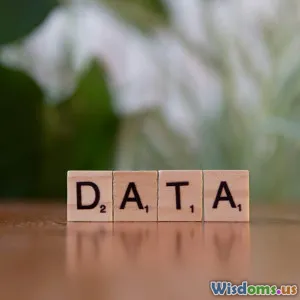
Are We Overcomplicating Data Exploration? Let’s Find Out
15 min read Examining if today’s data exploration tools are too complex and how simplicity can boost usability and results. (0 Reviews)
Are We Overcomplicating Data Exploration? Let’s Find Out
From massive data lakes to dashboards overloaded with options, today's data exploration landscape offers more tools and features than ever. Yet, for many analysts and business users, harnessing actionable insights often feels harder, not easier. If you’ve ever wondered whether we might be making data exploration more complicated than it needs to be, join us as we dig into today’s approaches, common pitfalls, and the path to clearer, smarter data discovery.
The Heart of Data Exploration: What Actually Matters

At its core, data exploration is about answering questions and generating insights using available information. However, as technology evolves, the essence sometimes gets lost in translation. Instead of focusing on the questions we aim to answer, many teams find themselves tangled in interface complexity, tool choices, and endless tweaking.
Consider the journey of a marketing analyst in 2010 versus 2024. Ten years ago, exploring customer behavior might have involved a simple Excel data dump, a pivot table, and some charts. Flash-forward: that same analyst might now face business intelligence tools, each with layers of filters, advanced modeling options, and integrations—many rarely used. The focus shifts from asking "What are my top customer segments?" to "How do I build this metric in the tool?"
Data exploration becomes most effective when the following remain central:
- User’s questions
- Relevant, clean data
- Accessible presentations (visualizations, summaries, narratives) that inform, not overwhelm
When approaching new projects, teams should ask: are we equipping users to find answers, or just handing them more options?
A Brief History: Simplicity to Complexity

The earliest data analysis involved straightforward techniques. Spreadsheets—VisiCalc, Lotus 1-2-3, and later Excel—brought powerful exploration capabilities using basic formulas, tables, and charts. Their magic was clarity and flexibility; anyone could learn the ropes in days, if not hours.
Fast forward through the rise of SQL, R, and Python, and data exploration began to blend programming with analysis. Then came the business intelligence boom: Tableau, Power BI, Looker, Domo, and more. Each promised user-friendly, drag-and-drop data discovery. Yet, for many, ease-of-use faded as tools accumulated features like predictive analytics, scripting, embedded ML, custom permissions, multi-cloud connectivity, and API extensions.
While progress brought innovation, it also led to what one Forrester analyst dubbed "feature fatigue syndrome" in enterprise data platforms. Ironically, the tools built for agility can become their own obstacle courses.
Example: Tableau's initial allure was instant data visualization, but advanced workflows now involve calculated fields, blend relationships, parameter controls, and complex server orchestration—a far cry from fast, direct insights if not guided carefully.
Why Do Tools Get So Complicated?

Toolmakers mean well: as demands have grown, they've responded with functionalities to cover every possible use case. Stakeholder requests—"Can we segment by region and device type? Automate this calculation? Support GDPR masking?"—drive feature adoption.
A 2022 survey by Dresner Advisory Services found that more than 70% of BI users regularly access only 20% of a platform’s core features. However, organizations rarely trim interfaces to match actual needs. Instead, the abundance of options can:
- Intimidate new users
- Distract experts from business goals
- Encourage "checkbox analytics," in which features are selected simply because they’re available
Take, for example, a mid-sized retailer deploying a cloud BI tool. Without customization, users log in to find 50+ chart types, hundreds of data filters, and options for embedded scripting. Results: confusion, resistance, and more time spent in onboarding. As Harvard Business Review succinctly put it: complexity is seldom empowering.
The High Cost of Overcomplication

The tendency to overcomplicate carries tangible downsides:
Wasted Time: Studies show that users spend up to 40% of their time searching for relevant data or configuring views, rather than analyzing results.
Missed Insights: More features don’t translate to better discoveries. In fact, cognitive overload often prevents seeing key patterns. For instance, a pharmaceutical company migrated to a powerful new analytics platform, but productivity dropped for six months before users reacclimated.
Shadow Analytics: When corporate tools frustrate, employees often revert to shadow analytics—exporting data into Excel or unauthorized apps, complicating governance and reducing trust in the official "single source of truth."
Example: An online travel agency’s data warehousing investment backfired as users, daunted by its query builder, created private spreadsheets. Senior management had discrepancies from conflicting metrics, leading to costly decisions and data reconciliation exercises.
Keeping Data Exploration Simple: Principles That Work

Organizations can counteract complexity by embracing a few pragmatic principles:
- Start with use cases, not features. Design tools and dashboards around specific questions and user paths, hiding or removing extraneous elements.
- Progressive disclosure. Borrow a UX concept: show basic controls by default, reveal advanced settings only as needed.
- Feedback cycles with end users. Regularly invite users to review workflows, providing insight into what works and what doesn’t.
- Data curation. Invest in curated datasets—clean, well-labeled subsets focused on the most impactful analysis.
Case Study: At a global FMCG company, a project to streamline supply chain analytics achieved wider adoption by restricting initial dashboards to four core KPIs. Additional data and filters became available only via toggle, reducing training times from months to weeks.
Tips & Frameworks for User-Friendly Exploration

1. Minimize Decision Points: For every screen or dashboard, scrutinize every option. Which selections are actually needed for the typical workflow?
2. Adopt Design Thinking: Engage usual and power users in design sessions; ask them to map desired journeys and pain points.
3. Template & Reference Dashboards: Provide easy-to-understand templates based on frequently asked questions (FAQs) about the business. This communicates best practices and reduces repetitive work.
4. Smart Defaults, Not Blank Slates: Pre-load meaningful default views, showing common breakdowns (e.g., sales by month, region, segment) so users see action as soon as data loads.
5. Gentle Onboarding: Layer support—walkthroughs, tooltips, and short explainer videos—for every new function that extends beyond the basics.
6. Empower, Don’t Overwhelm: Offer guided analysis—perhaps an "insights to try" sidebar or auto-generated narrations—to help less technical users notice interesting patterns.
Real-World Example: Datawrapper, a simple charting tool, intentionally keeps its interface spartan. Users upload data, select a chart type, and customize labels—no scripts or SQL required. As a result, content publishers rapidly produce clear, high-impact visuals for stories and reports. This "choose less, gain more" philosophy is echoed by rising no-code analytics vendors.
The False Equivalency: Features ≠ Flexibility
Too many leaders equate feature-packed with "future-proof"—but flexibility comes from fit for purpose, not from every capability imaginable. A lean tool stack, intelligently deployed, often outperforms a sprawling feature set that’s poorly understood.
A 2023 EMA survey found organizations with fewer than three analytics tools had significantly higher data-driven decision rates (64%) versus those with four or more tools (39%). The key difference? Deeper mastery and reduced confusion leading to more frequent, high-quality use.
Comparison Table:
| Approach | Pros | Cons |
|---|---|---|
| Minimalist Tooling | Clarity, speed, easier onboarding | Possible edge-case limitations |
| Max Feature Adoption | Broad coverage, technical adaptability | Steep learning curve, user resistance |
Tip: Schedule a quarterly "feature audit" for your analytics stack: what is used often? What could be removed or hidden?
Data Literacy: The Unsung Hero of Simplicity

While software simplicity matters, genuine ease comes from human skills. Data literacy—helping users understand datasets, patterns, interpretation, and pitfalls—is the secret sauce.
High-performing organizations build training into exploration tooling:
- Workshops on reading charts, questioning outliers, and interpreting dashboards
- Peer-led show-and-tells of analysis sessions
- Internal FAQs and data glossaries
Example: One fintech firm embedded “coach mode” in dashboards: as users explored, interactive prompts explained statistical methods behind results. This both taught basics and fostered critical thinking, leading to more insightful presentations in leadership meetings.
Automating Without Alienating

The next wave is "augmented analytics"—AI features that suggest trends, outliers, insights, or even visuals automatically. While automation promises to further streamline exploration, it can ironically heighten confusion if results seem like a "black box."
Actionable Advice:
- Prioritize explainability: Automated insights should be backed by plain-language explanations (“Anomaly detected: Q4 revenue >20% above trend due to X segment”).
- Stay transparent: Make logic, formulas, and data lineage visible, at least on demand, so users can trust recommendations.
Case Study: In 2023, a healthcare analytics vendor combined automated summaries with "show me how" guides. Users reported a sharper uptick in engagement and insight retention compared to legacy static dashboards. Success depended on AI being assistive—not intrusive or mysterious.
Choosing the Right Path Forward

So are we overcomplicating data exploration? In many cases, yes—but the solution isn’t to avoid modern tools or cut features indiscriminately. It’s in refocusing on the real needs of your analysts, business users, and stakeholders:
- Foster dialogue: Collaborate between IT, BI, and frontline users to shape tools and workflows.
- Reduce mental clutter: Remove or hide rarely used features, and use progressive disclosure.
- Curate and educate: Prioritize data literacy alongside technical capability.
- Value speed to insight over raw capability.
Every click, configuration screen, or option should be in service of helping people find meaning in data. The next generation of analytics will celebrate human-centered simplicity, offering the same excitement for discovery as a well-made, insight-rich spreadsheet—and certainly a whole lot more productivity.
Rate the Post
User Reviews
Popular Posts


















